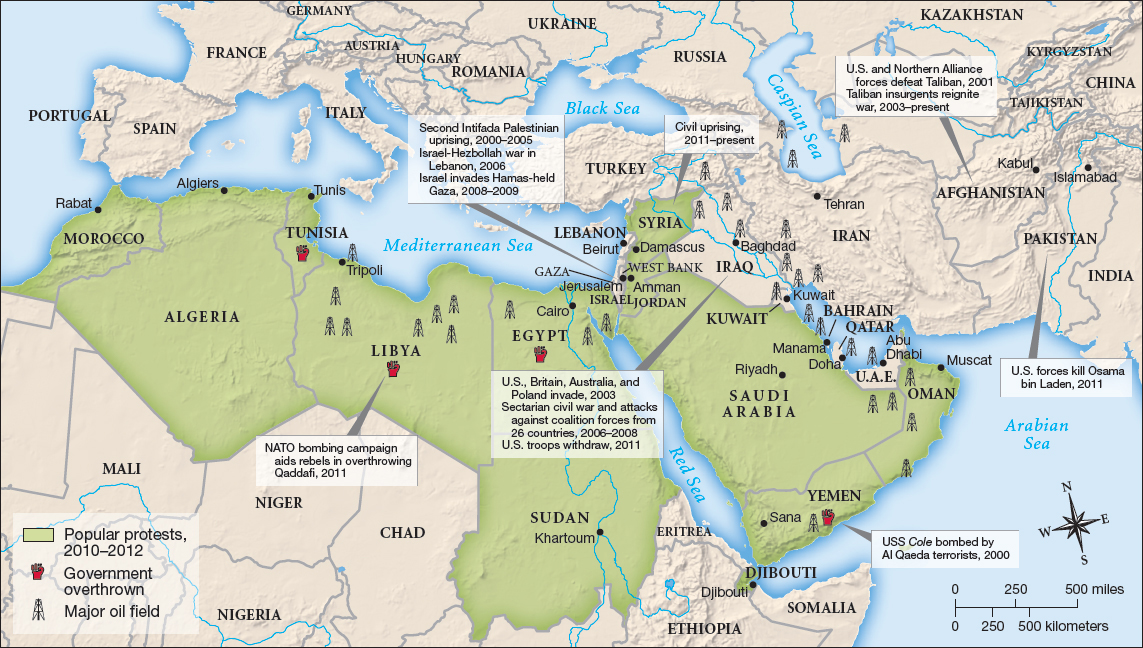Exploring American Histories: Printed Page 947
Exploring American Histories, Value Edition: Printed Page 779
An Unfinished Agenda
The United States will continue to face serious tests to its international leadership in the twenty-first century. Terrorism remains a potent threat. Iraq has yet to prove that it can survive as a stable nation in the absence of a strong American military presence, and the outcome of the war against al-Qaeda and the Taliban in Afghanistan remains questionable. Despite Osama bin Laden’s death, al-Qaeda in Yemen still poses a serious danger, and U.S.-trained Afghan forces must demonstrate that they can maintain control once the U.S. military withdraws. If Iran succeeds in developing nuclear weapons, it will present an even greater threat, as will the continuing stalemate between the Israeli government and the Palestinians in reaching agreement over issues of peace and land that have been unresolved since 1967.
In 2011 great changes swept across the Middle East, as young people, armed mainly with cell phones and connected through social media networks, peacefully toppled pro-Western but despotic governments in Egypt and Tunisia. In Libya, armed rebels succeeded in overthrowing the government of the dictator Muammar al-Qaddafi. Elsewhere, a hostile North Korea has developed nuclear weapons. Prolonged instability in the Middle East, the Persian Gulf, and Asia is harmful to U.S. security interests and to achieving lasting peace in these regions (Map 29.2).

Whatever happens in the war on terror, the United States still faces challenges of globalization. China, a nation of 1.3 billion people, is contesting American economic supremacy. As China flourishes economically, American workers have lost jobs, and the Chinese have amassed a nearly $200 billion trade surplus with the United States. China also owns a substantial portion of America’s national debt, a situation that further alters the balance of economic power between the two nations. In addition, the growth of manufacturing and the market economy in China has resulted in the rising consumption of oil and gasoline, thereby adding to soaring fuel prices in the United States.
Along with the United States and China, the rest of the world faces the problem of climate change and ultimately the survival of the planet. Global warming during the twentieth century resulted mainly from emissions of greenhouse gases into the atmosphere and the erosion of the ozone layer. As temperatures climb, they cause a rise in the sea level, the melting of glaciers, extreme fluctuations of weather, and famines. Powerful hurricanes such as Katrina have been attributed to rising temperatures in the Atlantic Ocean and Caribbean. Disruptions in industrial production caused by storms and the subsequent expense of rebuilding have a negative impact on the U.S. and world economies. (See e-Document Project 29: The Environment and Federal Policy in the Twenty-First Century.)
As the twenty-first century unfolds, immigration will continue to arouse considerable political controversy. Immigration restrictionists, particularly in Arizona and California, support such policies as building a fence along the U.S.-Mexican border and strengthening the administration of immigration laws. Supporters of immigration reform favor amnesty for illegal residents who have lived in this country for a designated period and have jobs, opening up a path to citizenship. At the heart of this issue is the question that has always existed during periods of intense foreign immigration, especially from non-English-speaking nations: Do the nation’s vitality and character still depend on welcoming a new generation of foreigners to make their living and their home in the United States? Whatever the answer, by the end of the twenty-first century the population of the United States will look much different. The percentage of Latinos and Asian Americans will increase, while that of whites and blacks will decline. In 2012 the U.S. Census Bureau reported that nonwhite babies made up the majority of births for the first time. If present trends continue, the country’s racial and ethnic composition will become much more mixed through intermarriage. In 2010 the Census Bureau reported that one of seven new marriages, or 14.6 percent, was interracial or interethnic. In 1961, when Barack Obama was born, the figure for interracial marriages was less than one in a thousand. And, as for the institution of marriage, we can expect its legal recognition to expand to gays, although in 2012 voters approved state referenda that rejected same-sex marriage.
Review & Relate
|
What were the causes and consequences of the Great Recession? |
What effects did the election and presidency of Barack Obama have on American politics and society? |